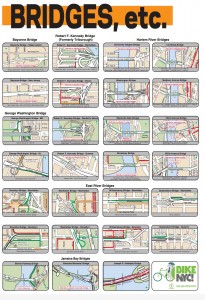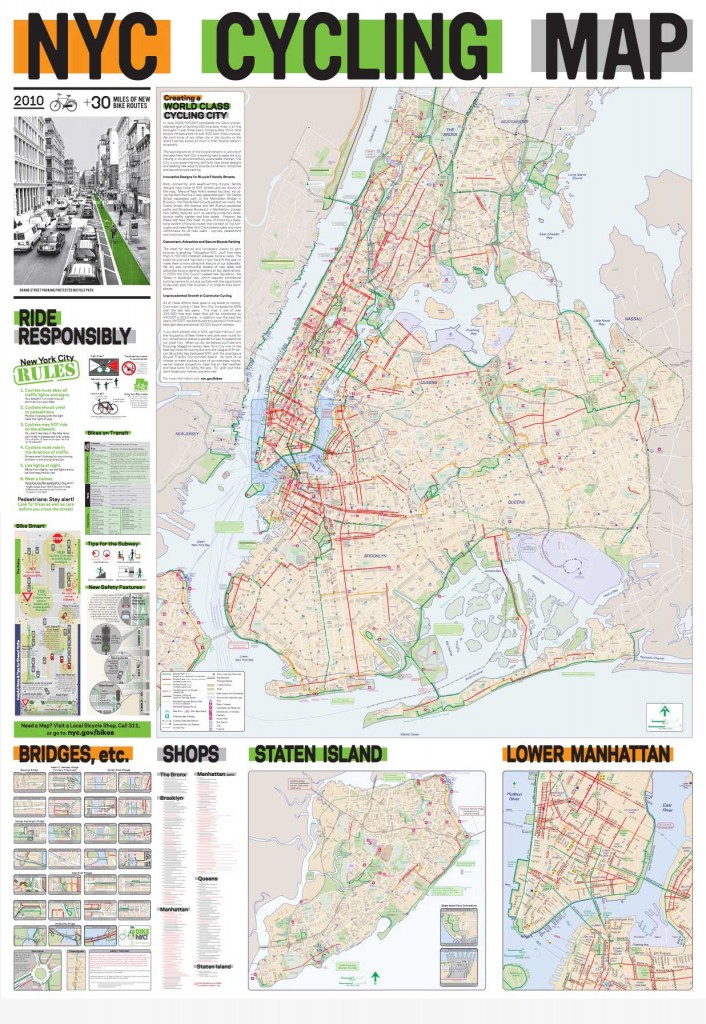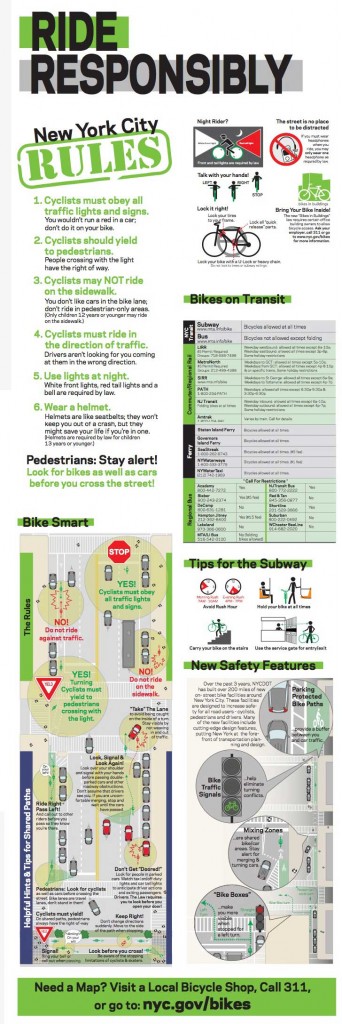NYC Invests in Cycling
 New York City has really stepped into the forefront of planning for alternative transportation. It is laying down bike lanes like nobody’s business. It’s opening more riverfront to pedestrians and cyclists than I’ve ever seen in my life in the Big Apple. I(See the map at right.) NYC is closing sections of main thoroughfares like Broadway and opening pocket parks seemingly every day. And not least, it is making available more information about how to cycle safely and park your ride securely than perhaps any other city outside of the Northwest. New York is the big Magilla of cities and increasingly it’s setting the nation’s big-city cycling agenda. Indeed it is succeeding in innovating new approaches to active transportation across the five boroughs where policymakers have in the past literally paved the way for non-motorists.
New York City has really stepped into the forefront of planning for alternative transportation. It is laying down bike lanes like nobody’s business. It’s opening more riverfront to pedestrians and cyclists than I’ve ever seen in my life in the Big Apple. I(See the map at right.) NYC is closing sections of main thoroughfares like Broadway and opening pocket parks seemingly every day. And not least, it is making available more information about how to cycle safely and park your ride securely than perhaps any other city outside of the Northwest. New York is the big Magilla of cities and increasingly it’s setting the nation’s big-city cycling agenda. Indeed it is succeeding in innovating new approaches to active transportation across the five boroughs where policymakers have in the past literally paved the way for non-motorists.
Making change in the transportation arena in the Big Apple is not without its challenges, of course. Residents are fighting back against bike lanes in some quarters of the city. And the Bloomberg administration may have lost some high-profile battles in Albany – no bastion of progressive idealism in transportation or any other policy area. Mayor Bloomberg made a big push for ‘congestion pricing’ to put a cost to auto travel into the center of town. And he wanted to impose tools on (now-free) East River bridges. They cost a fortune to maintain and serve motorists most conspicuously, but unlike nearly every other crossing they are free, free, free. A pedestrian or cyclist pays more to take a subway than a motorist does for the convenience (not to mention negative effects) of driving into the metropolis. But policymakers balked.
The parochial thinking that often dooms progressive policies stands in stark contrast to what has been achieved. Take for example the city’s rollout of an ambitious bike routes program under Janette Sadik-Khan, the Commissioner of the New York City Department of Transportation appointed by Bloomberg in 2007. As the map (right) indicates, the city has identified what amounts to a five-borough network of interconnected routes and set about making them a reality.
Kahn also spearheaded the closure of Broadway to motorists in Times Square, which was absolutely unthinkable until the city proposed it only a couple of years ago. Ditto for a rapid busway down the center of 42nd street, which pre-Bloomberg (remember Rudy Giuliani?) would have driven taxi drivers to riot. Somehow in today’s Big Apple, polished to such a gloss that a born-and-bred New Yorker only faintly recognizes the place, these ideas not only are proposed, they actually happen.


New York shows how it’s done. Ancillary support materials can make a big difference in how cyclists perceive the institutions. That helps get us past mistrust and working toward the collaborative pursuit of policies to keep us safe on the roads.
You’ve got to be a real dyed-in-the-wool New Yorker to miss the wormy aspects of the Big Apple of yesterday, and today one has to venture into the boroughs to rediscover the New York of yesterday. Thanks to the new network of bike routes, one can get out to these places on two wheels. The city has even carefully marked routes across bridges (on main map) and provided a handy cycling do-and-don’t tip sheet.
New York’s efforts have extended to the creation of a suite of excellent maps and flyers (at left) that communicate the rules of the road and the basics of two-wheel etiquette (at left).
These maps, brochures, well-marked routes and especially the new infrastructure of lanes all suggest to stakeholders and motorists alike that cyclists belong. That’s a message welcomed as long-overdue by the cycling community.
Here in the Los Angeles region, we’re still catching up. Perhaps even worse, our unique patchwork of municipalities and counties makes coming together around a regional bike map – much less a regionally-coherent set of policies – that much more of a challenge.
New York is 8 million people, many of whom already use non-auto transportation on a daily basis. As a city with centralized political control (and a strong-mayor system) they can get things done.
Los Angeles, by contrast, is a city of 4 million, but it’s only a drop in the bucket in the larger auto-centric LA region. Los Angeles tends to set the agenda where cycling is concerned (a recent change!) but the political challenges remain: getting policymakers from cities throughout the region – including Beverly Hills – on board.
